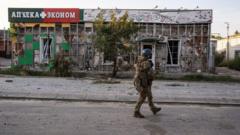On October 7, 2023, an unprecedented order was issued by Israel's military, instigating one of the most intense bombing campaigns in recent warfare history. The directive allowed mid-level commanders to target a wider array of Hamas militants—extending even to low-ranking members—without the previous protections that restricted civilian casualties.
Israel's Shift in Airstrike Policy Leads to Increased Civilian Casualties

Israel's Shift in Airstrike Policy Leads to Increased Civilian Casualties
In the wake of heightened hostilities, Israel revised its military engagement rules, resulting in significant civilian losses during operations in Gaza.
Historically, Israeli military operations enforced strict protocols aimed at minimizing civilian harm, with a standard limit of five civilian casualties that rarely exceeded ten in targeted attacks. However, the focus shifted dramatically when military leaders believed an existential threat loomed, prompting them to allow strikes that could endanger up to twenty civilians per airstrike.
This significant alteration in the rules of engagement marks a decisive moment in Israel's approach to conflict, reflecting the tense atmosphere after the October 7 attack. As reported by multiple sources, military leaders felt they had to respond vigorously to perceived threats from Hamas, leading to a surge in bombings that inadvertently resulted in one of the highest death tolls in recent conflicts.
The scope of this military campaign and its tragic fallout have drawn scrutiny, with reports indicating that prior military strategies were abandoned in favor of a more aggressive posture that prioritized retaliation over civilian safety. Continued analysis and discussions surrounding these developments are vital as the conflict persists and its ramifications unfold.
This significant alteration in the rules of engagement marks a decisive moment in Israel's approach to conflict, reflecting the tense atmosphere after the October 7 attack. As reported by multiple sources, military leaders felt they had to respond vigorously to perceived threats from Hamas, leading to a surge in bombings that inadvertently resulted in one of the highest death tolls in recent conflicts.
The scope of this military campaign and its tragic fallout have drawn scrutiny, with reports indicating that prior military strategies were abandoned in favor of a more aggressive posture that prioritized retaliation over civilian safety. Continued analysis and discussions surrounding these developments are vital as the conflict persists and its ramifications unfold.























